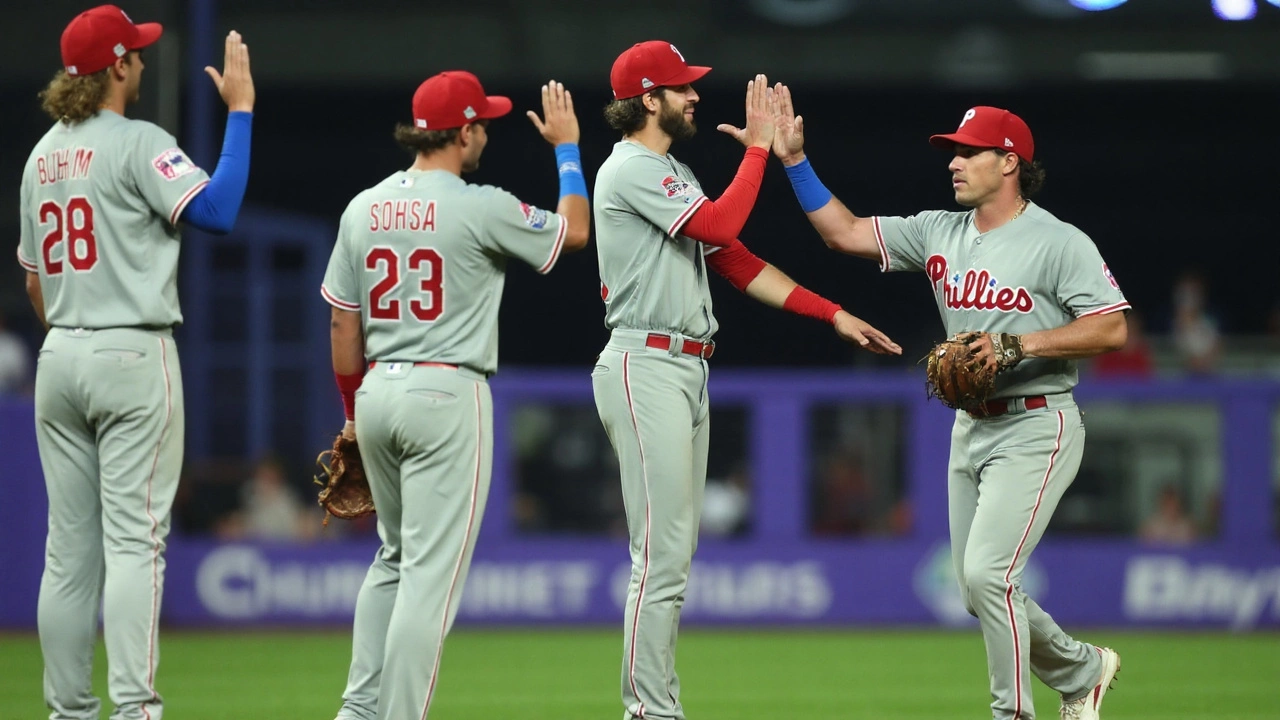A birthday home run, an argument in the seats, and a viral villain
A home run ball is supposed to be a simple joy. In Miami on Friday, September 5, 2025, it turned into a national flashpoint. During the Phillies’ 9-3 win over the Marlins at loanDepot park, a clip raced across social media showing a woman in Phillies gear confronting a father who had just handed a home run ball to his young son, Lincoln, for his birthday. In the videos, the woman insists the ball was in her hands first, grabs the father’s arm, and pressures him to give it up. The dad, clearly uncomfortable and surrounded by a rising chorus of boos, takes the ball back from his son and hands it to her. The crowd’s mood hardens. She flips off nearby fans who call her out. And the internet gives her a name: Phillies Karen.
The moment swallowed the game itself. Harrison Bader’s blast to the left-field seats is the reason anyone had a ball to fight over, but the aftermath is what stuck: a birthday kid caught in the middle, a parent trying to defuse a scene, and a fan doubling down as phones recorded every second. Within hours, the clip was everywhere—on TikTok, on X, on Instagram Reels—spawning comment threads, meme edits, and the kind of instant judgment that defines sports viral culture.
Here’s what the videos show and what they don’t. The first clip captures the handoff from the father to his son, Lincoln, followed by the confrontation. You can see the woman reach for the dad’s arm and hear her claim: “It was in my hands first.” The second clip picks up later, after the section has turned on her. She responds to the heckling by holding up her middle finger. There’s no sign in the public footage of security stepping in or anyone being ejected. Neither MLB nor the Marlins have publicly detailed any disciplinary action tied to the moment.
The family’s night, at least, didn’t end on a sour note. Marlins staff found Lincoln and apologized. In a video shared after the game, a team representative tells him, “That was not OK. So we brought you a cool little goodie bag. I’m so sorry.” Later, the boy met Harrison Bader, who signed a bat and gave it to him—a gesture that turned a viral fiasco into a memory he’ll actually want to keep.
Why did this blow up so fast? Because it hits a nerve. Baseballs flying into the stands are one of the sport’s purest traditions. The accepted etiquette—catch it clean, and if there’s a kid nearby, consider handing it over—feels simple. But unwritten rules become messy when two people think they’ve both earned the same souvenir. And when there’s a camera rolling, a fight over a $20 ball becomes a referendum on decency.

Who owns a home run ball, what stadium etiquette says, and how the internet made it worse
Let’s clear up the basics. As a general rule, fans can keep baseballs that are hit or thrown into the stands. Most clubs post versions of that policy in-park. But that doesn’t answer the trickier question: who owns the ball when more than one person touches it? In practice, it comes down to possession—who secured control first, without losing it.
That distinction isn’t just fan folklore. A famous case, Popov v. Hayashi (San Francisco Superior Court, 2002), wrestled with Barry Bonds’ 73rd home run ball. One fan got it in his glove but was swarmed; another ended up holding it. The court recognized a “pre-possessory interest” for the first fan, acknowledging he was prevented from completing the catch by interference, then ordered the ball sold and the proceeds split. Stadium squabbles don’t turn into court cases, but the logic still matters: touching a ball isn’t the same as controlling it. The person who actually secures it—without being mobbed—usually keeps it.
Etiquette, though, is a different thing. There’s a strong custom, especially for regular-season balls, to give them to kids when you can. It’s not a rule, but it’s ingrained in baseball culture. TV crews pan to smiling families, teams reward those moments on the jumbotron, and strangers cheer. When the opposite happens—an adult takes a ball from a child—the backlash is instant and unforgiving. That’s what you saw in Miami. The crowd didn’t need a legal memo; they needed the moment to feel fair.
There’s also safety and sportsmanship. Grabbing someone’s arm in the stands is a bad idea. Emotions run hot after a scramble, but pushing, yanking, or lunging can get people hurt, especially with kids nearby and concrete steps underfoot. Teams have fan codes of conduct that ban harassment and aggressive behavior. They don’t always intervene in disputes over souvenirs, yet they do draw the line at physical contact and ongoing disruption.
The Miami scene didn’t end in a brawl—thankfully—but it did spill onto the internet. And that’s where the second mess started. As the clip spread, social media users tried to identify the woman. They got it wrong. One woman, Cheryl Richardson-Wagner, was falsely labeled as the person in the video. She jumped online to set the record straight, saying she’s a Red Sox fan, not a Phillies fan, and that she wasn’t even in Florida that night. She swapped her Facebook cover photo to a Boston logo to drive the point home. Meanwhile, the actual identity of the woman in the clip remains unconfirmed.
Misidentification is not a minor error; it’s a real-world risk. People who get wrongly named face harassment, job threats, and doxxing. In sports circles, we’ve seen this before: a heated clip leads to armchair sleuthing, and innocent people get dragged. The Miami case is a fresh reminder—viral justice is not justice.
So what happens next? Officially, probably nothing public. Team security reports are rarely released, and unless the woman is identified by the club and banned (which would usually require clear cause and a confirmed identity), the story lives on mainly as a cautionary tale. The Phillies and Marlins haven’t announced any formal steps tied to the dispute. What they did do—especially Miami—was step in to restore the kid’s experience. In Major League parks, that’s standard practice: when a moment goes sideways, a team rep will often bring a replacement ball, a cap, or a bag of merch. Sometimes a player gets involved. Bader’s signed bat did exactly what teams hope those gestures do—shift the focus back to the game and the joy that drew everyone there in the first place.
None of that erases the larger conversation. Clips like this pop up every season, each time sparking the same debate: What’s fair in a souvenir scramble? Who should back off? And when someone refuses to read the room, what’s the right response from those around them? Yes, booing and shaming can escalate things. But community standards in the stands are real. Fans police their own, and most of the time, it works.
There’s also the kids factor. When a child is visibly part of a moment—birthday badge on, overwhelmed grin, parents tearing up—most people lean toward generosity. That doesn’t mean a kid is entitled to every ball in their section. It does mean that when there’s a clean, obvious way to make a memory, adults usually take it. It’s why the Miami confrontation hit a national nerve: a happy, simple thing got complicated, and a child paid the price in tears before the team stepped in.
Zoom out, and you see how much meaning we load onto a scuffed baseball. It’s a $20 object with mile-high emotional value. It’s a connection to the player who hit it, a timestamp on a family story, a small piece of proof that you were there. When two people think the same ball is theirs, they’re really fighting over whose memory gets to exist.
As for the game itself, it hardly mattered in the timeline. The Phillies put up nine runs and handled the Marlins by six. Bader, the man who started the chain of events with a swing, closed the loop by meeting Lincoln after the final out. Sports produce villains and heroes in minutes; sometimes the villain is just a fan having a bad night, and sometimes the hero is a player who takes five minutes to show kindness.
If you’re heading to a game soon, here’s a simple playbook for avoiding this kind of drama:
- Secure first, celebrate second. If the ball’s bobbling around, don’t claim it until you’ve actually got control.
- Hands to yourself. No grabbing arms, no shoving. The ball isn’t worth an injury—or a stadium ban.
- Read the room. If a kid obviously just got the ball for a special moment, consider letting them have it or offering a quick trade for another souvenir.
- Ask, don’t demand. If you think you had a claim, use your words, not your hands. Most fans will talk it out.
- Don’t feed the pile-on. If a moment gets heated, flag an usher. Internet justice often makes things worse.
Will this change anything league-wide? Don’t expect new rules about who gets a ball. MLB and teams prefer broad conduct guidelines over micromanaging souvenirs. But security briefings do evolve with viral moments. Expect more reminders to de-escalate and to involve staff early when arguments flare.
There’s a lasting takeaway from Miami, and it isn’t complicated. Stadiums run on shared kindness. When that breaks, the clips fly and reputations burn. The kid in this story still walked away smiling, bat in hand, because adults around him—team staff, a player, fellow fans—stepped up. That’s the culture most people want in the stands. The rest is just a ball.
